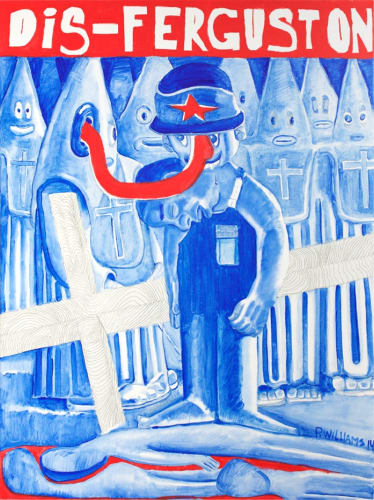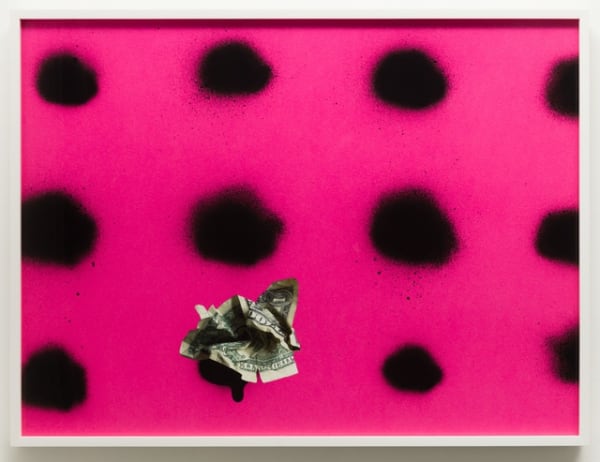CONTEXTUAL PROPORTIONS: Sadie Barnette, Adriana Corral, Kenturah Davis, Johnathan Payne, Esteban Ramón Pérez, Kameelah Janan Rasheed, and Peter Williams.
Jenkins Johnson Projects, Brooklyn is pleased to present Contextual Proportions, an exhibition curated by Kenturah Davis, featuring works by Sadie Barnette, Adriana Corral, Kenturah Davis, Johnathan Payne, Esteban Ramón Pérez, Kameelah Janan Rasheed, and Peter Williams.
Contextual Proportions examines the ways in which artists work with text and is inspired by Toni Morrison’s essay Sites of Memory, which states, “If writing is thinking and discovery and selection and order and meaning, it is also awe and reverence and mystery and magic.” The artists in the show work with text as a flexible material that can both amplify and diffuse ideas. They leverage written language to explore dualities including: legibility/illegibility and meaning/mystery. In the work of Adriana Corral and Sadie Barnette, classified/declassified documents are presented to confront systems meant to obfuscate truth to sustain the powers of the state. Kenturah Davis, Kameelah Janan Rasheed, Esteban Ramón Pérez, and Peter Williams use charged and visually graphic text to engage with social and political issues. Johnathan Payne’s works obscure text through weaving in order to unravel the narrative force and tropes of comic books to assert other possibilities.
Jenkins Johnson Projects, Brooklyn is pleased to present Contextual Proportions, an exhibition curated by Kenturah Davis, featuring works by Sadie Barnette, Adriana Corral, Kenturah Davis, Johnathan Payne, Esteban Ramón Pérez, Kameelah Janan Rasheed, and Peter Williams.
Contextual Proportions examines the ways in which artists work with text and is inspired by Toni Morrison’s essay Sites of Memory, which states, “If writing is thinking and discovery and selection and order and meaning, it is also awe and reverence and mystery and magic.” The artists in the show work with text as a flexible material that can both amplify and diffuse ideas. They leverage written language to explore dualities including: legibility/illegibility and meaning/mystery. In the work of Adriana Corral and Sadie Barnette, classified/declassified documents are presented to confront systems meant to obfuscate truth to sustain the powers of the state. Kenturah Davis, Kameelah Janan Rasheed, Esteban Ramón Pérez, and Peter Williams use charged and visually graphic text to engage with social and political issues. Johnathan Payne’s works obscure text through weaving in order to unravel the narrative force and tropes of comic books to assert other possibilities.
Sadie Barnette’s works engage as primary source material the 500-page FBI surveillance file kept on her father, Rodney Barnette, who founded the Compton, California, chapter of the Black Panther Party in 1968. In the artist’s hands these repressive documents are reclaimed — splashed with pink spray paint and adorned with crystals — in an intergenerational assertion of the power of the personal as political. Barnette’s work deals in the currency of the real, in earthly acts of celebration and resistance, but is also tethered to the other-worldly, a speculative fiction, a galactic escape. As the artist says, “This is abstraction in service of everyday magic and survival in America.” Barnette earned a BFA from CalArts and an MFA from the University of California, San Diego. Her work is in collections including LACMA, Berkeley Art Museum, the California African American Museum, the Cornell Fine Arts Museum, the Pérez Art Museum in Miami, Studio Museum in Harlem (where she was also Artist-in-Residence), Brooklyn Museum and the Guggenheim. She is the recipient of Art Matters and Artadia awards and has been featured in publications such as The New York Times, The Los Angeles Times, Artforum, and Vogue.
Adriana Corral's minimal works shed light on histories of political violence throughout Central and South America, particularly the widespread phenomenon of enforced disappearances of women and girls. Working in collaboration with a human rights attorney, Corral gained access to classified documents pertaining to the landmark legal case, Campo Algodonero v. México which found the Mexican government complicit in the 2001 homicides of eight young girls in Ciudad Juarez, Chihuahua, Mexico. Ultimately, the documents on the surface are illegible echoing the intentional erasure of histories of violence from public knowledge. Corral was invited to attend the 106th session of the Working Group on Enforced and Involuntary disappearances at the United Nations in Geneva, Switzerland, selected for the Joan Mitchell Foundation Emerging Artist Grant, named Artists to Watch 18 exceptional new talents by Modern Painters and recently attended the International Artist-in-Residence at Artpace, Künstlerhaus Bethanien Residency in Berlin, Germany and is a current fellow at Black Cube, a Nomadic Art Museum based in Denver, Colorado. She received her M.F.A. in 2013 from the University of Texas at Austin.
Kenturah Davis’s large-scale drawing uses text from 13th Amendment of the US Constitution, which abolished slavery. The figure exists in a liminal position, between floating and falling. In this multi-panel drawing she explores the range of implications that this body of text has on the figure and the world around us. The work can also exist as loose-leaf book that can be displayed as a stack. An accompanying video shows the artist with the stack on her head, literally and figuratively showing the difficulty of balancing this burden. Davis was short-listed for the Smithsonian National Portrait Gallery's 2019 Outwin Boochever Portrait Competition. Currently, she is a fellow at NXTHVN, founded by Titus Kaphar and Jonathan Brand. She has also exhibited at the Robert and Frances Museum of Art, San Bernardino, CA; the Accademia di Belle Arti di Venezia, Venice, Italy; Ucity Museum, Guangzhou, China; Torrance Art Museum, CA; Ian Potter Museum, Melbourne, Australia and the Yokohama Triennale, Yokohama, Japan. In 2014, she was commissioned by Alliance Française Accra Mural series to commemorate International Women’s day. Davis’s work has been featured in The New York Times, Los Angeles Magazine, and Vice, among others. She graduated from the Yale School of Art with her MFA in 2018 and Occidental College, BFA.
Investigating race through text and images, Kameelah Janan Rasheed’s works use expressions of everyday vernaculars and experimental poetics. Many of her images appear warped or stretched to the edge of legibility, like they’ve been manipulated on the bed of a photocopier. (Occasionally, we see the artist’s fingers reproduced on the pages.) Rasheed’s material choices also explore a taxonomy of blackness, from the inks of various kinds of prints to a reflective sheet of black Plexiglas, or a shadow thrown from an overhead projector. She aims to interrupt the speed and care with which we normally encounter language in the context of the city street, an essay, a gallery exhibition or in other environments, encouraging us to actively make meaning alongside, through and with the works. Rasheed received her MA in Secondary Education from Stanford University and a BA from Pomona University in Public Studies and Africana Studies. Her work has been exhibited at the 2017 Venice Biennale, Institute of Contemporary Art Philadelphia, the Bronx Museum and the Studio Museum in Harlem, and is in the permanent collection of the Schomburg Center for Research in Black Culture. She has been written about in publications including Artforum, Hyperallergic, Frieze, and The New York Times. Recently she was shortlisted for the Future Generation Prize.
Esteban Ramón Pérez is concerned with the intersections of materiality and iconography within American cultures, their implications, and their relationship to subcultures, labor practices, social classes, and socio-political histories. The content within each of his works is meant to be multifaceted, usually containing aspects of art histories, subjectivity, spirituality, and social issues. His painting, Color Coded investigates how color has been politicized and culturally defined, and also how language contextualizes and charges the specifics colors. Pérez states, “I wanted to mess with that by describing the layer's colors with a complimentary color that I thought was still relevant to that layer; like black written in white, black being the layer of space, starlight seeming white from earth, etc.” The text used was inspired by Chicano-style graffiti tagging from the 1960’s-today. The black gothic lettering has been long used in Mexican culture as a way to charge language with a spiritual devotion. Pérez received his BFA in Art from the California Institute of the Arts in 2017, and his MFA in Painting & Printmaking from Yale University in 2019.
Peter Williams chronicles current and historical events, interspersing pictorial narratives with personal anecdotes and fictional characters in order to create paintings about the diverse experiences of Black Americans. With boldness and humor, he tackles the darkest of subjects including, but not limited to, police brutality, lynching, slavery, mass incarceration, and other realms of racial oppression. Williams uses cultural criticism to form new creation myths, retelling the history of America from fresh and cosmic perspectives. Peter Williams’s practice spans more than forty years, and he is Senior Professor in the Fine Arts Department at the University of Delaware. He earned his MFA from the Maryland Institute of Art. In 2018 Williams was inducted into the National Academy of Design. His paintings are held in collections including the Smithsonian American Art Museum, Whitney Museum of American Art, Walker Art Center, Detroit Institute of Arts, and the Delaware Art Museum. In spring of 2020 he will have a solo exhibition at the Museum of Contemporary Art Detroit curated by Larry Ossei-Mensah with Rebecca Mazzei.
Johnathan Payne’s work bridges the engendered, sexualized, and racialized histories of Modernist geometric abstraction and color field painting with Countercultural craft-based practices. Payne explores concepts of multiplicity, systems, and color mixing across varying mediums and processes. His collage-based works use comic images taken from varying sources to create paper weavings and wall hangings. He manipulates the scale and color of these images, prints them, shreds them, and uses the strips to make complex, process-based compositions. Payne intentionally embellishes, obscures, and deconstructs surfaces to convey the migrator and temporal nature of gestures, mediums, and pictures within their art practice. Johnathan Payne received his MFA in Painting and Printmaking from Yale University in 2018 and will be partaking in Crosstown Arts’ Artist in Residency program in 2020.
-

Kenturah Davis
Study for Entanglements, 2019
kozo paper, ink, China marker, aerosol paint
100 x 200 in. -

Kameelah Janan Rasheed
WE (BEEN) KNEW, II, 2019
archival pigment print
40 x 30 in. -

Esteban Ramón Pérez
Color Coded, 2016
acrylic on unstretched canvas
72 x 60 in. -

Peter Williams
Dis-Ferguston, 2014
oil on canvas
48 x 36 in. -

Sadie Barnette
Untitled (Dollar on Pink), 2019
archival pigment print
37 1/2 x 50 in. -

Adriana Corral
Untitled (Campo Algodon series), 2012
confidential documents transferred on gessoboard
24 x 24 in. -

Johnathan Payne
They're Changing!, 2019
woven inkjet print on cardstock
each: 10 5/8 x 7 3/8 in








